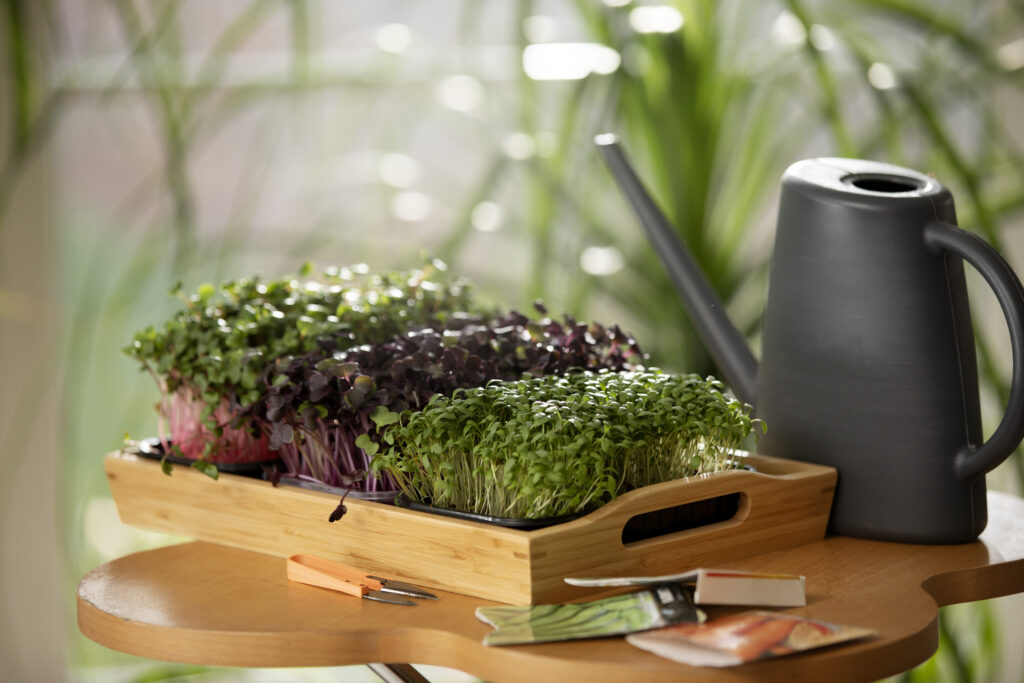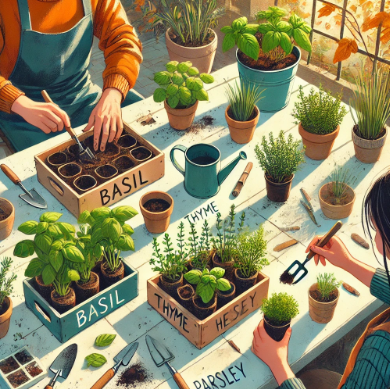Container herb gardening is an ideal way for beginners to cultivate fresh herbs like basil, thyme, and parsley right at home, especially during the fall planting season. Growing herbs in pots allows for easy management, versatility in placement, and year-round access to fresh flavors. With proper care and attention, you can create a thriving herb garden that enhances your culinary dishes and adds beauty to your home. This guide will walk you through the essential steps for growing basil, thyme, and parsley in containers, ensuring a successful start to your herb gardening journey.

1. Choosing the Right Containers
Selecting the right pots is the first step in ensuring your herbs thrive. Containers should be at least 6-12 inches deep, providing enough room for the roots to grow. Opt for pots with good drainage, as herbs like basil and parsley are sensitive to overwatering. Terracotta, ceramic, or plastic pots are all suitable choices, but ensure that each container has drainage holes at the bottom to prevent water from accumulating.
2. Using Quality Potting Mix
The success of your container herb garden depends largely on the quality of the soil. Regular garden soil is too dense for containers and can lead to poor drainage, so it’s essential to use a high-quality potting mix. Choose a well-draining mix with organic matter, which provides the nutrients and aeration your herbs need to grow strong and healthy. Consider adding perlite or vermiculite to the mix for improved drainage and root development.
3. Planting Basil, Thyme, and Parsley
Basil:
Basil is a tender herb that thrives in warm conditions, making it a great candidate for fall planting in mild climates. If you’re planting in fall, ensure that basil gets full sunlight, ideally 6-8 hours a day. Plant seeds or transplants in individual pots or group them with other herbs that share similar watering needs. Basil requires consistent moisture but avoid waterlogging the roots.
Thyme:
Thyme is a hardy perennial herb that adapts well to container gardening. It can tolerate cooler temperatures and thrives in full sun or partial shade. Plant thyme in shallow pots with a well-drained potting mix, and water sparingly, as thyme prefers drier soil conditions. It’s a low-maintenance herb, making it perfect for beginners who want a resilient plant during fall.
Parsley:
Parsley is a biennial herb that grows well in containers and is ideal for cooler fall weather. It prefers rich, moist soil and needs around 4-6 hours of sunlight daily. Curly and flat-leaf parsley varieties are both suitable for container planting. Since parsley can take time to germinate, it’s best to start from young plants or sow seeds indoors before transplanting outdoors.
4. Watering and Fertilizing
One of the most common mistakes beginners make is overwatering their herbs. While herbs like basil, thyme, and parsley need consistent moisture, they do not like soggy soil. Water your herbs when the top inch of the soil feels dry, and ensure proper drainage by emptying any excess water from the saucers under the pots. Herbs also benefit from light fertilization. A balanced, organic liquid fertilizer applied once a month will give your plants a boost without overwhelming them.
5. Positioning Your Herb Containers
The location of your herb containers can make a significant difference in their growth. Place them in an area that receives at least 4-6 hours of sunlight daily. For fall planting, choose a sunny spot that is protected from strong winds and sudden drops in temperature. If you live in an area with unpredictable fall weather, consider placing your containers near a south-facing wall or under a sheltered porch where they can be moved indoors if necessary.
6. Harvesting Your Herbs
Once your herbs are established, you can start harvesting them regularly. For basil, pinch off the top leaves to encourage bushier growth, and for thyme, snip sprigs as needed, ensuring not to cut more than one-third of the plant at a time. Parsley can be harvested by cutting the outer stems, allowing the inner leaves to continue growing. Regular harvesting promotes new growth and keeps your herbs productive.
Conclusion
Container herb gardening is a perfect starting point for beginners looking to grow herbs like basil, thyme, and parsley. With the right containers, potting mix, and care, you can create a thriving herb garden that will provide fresh, flavorful herbs well into the fall season and beyond. Whether you’re an experienced gardener or just getting started, these versatile herbs are a great addition to any home garden.

